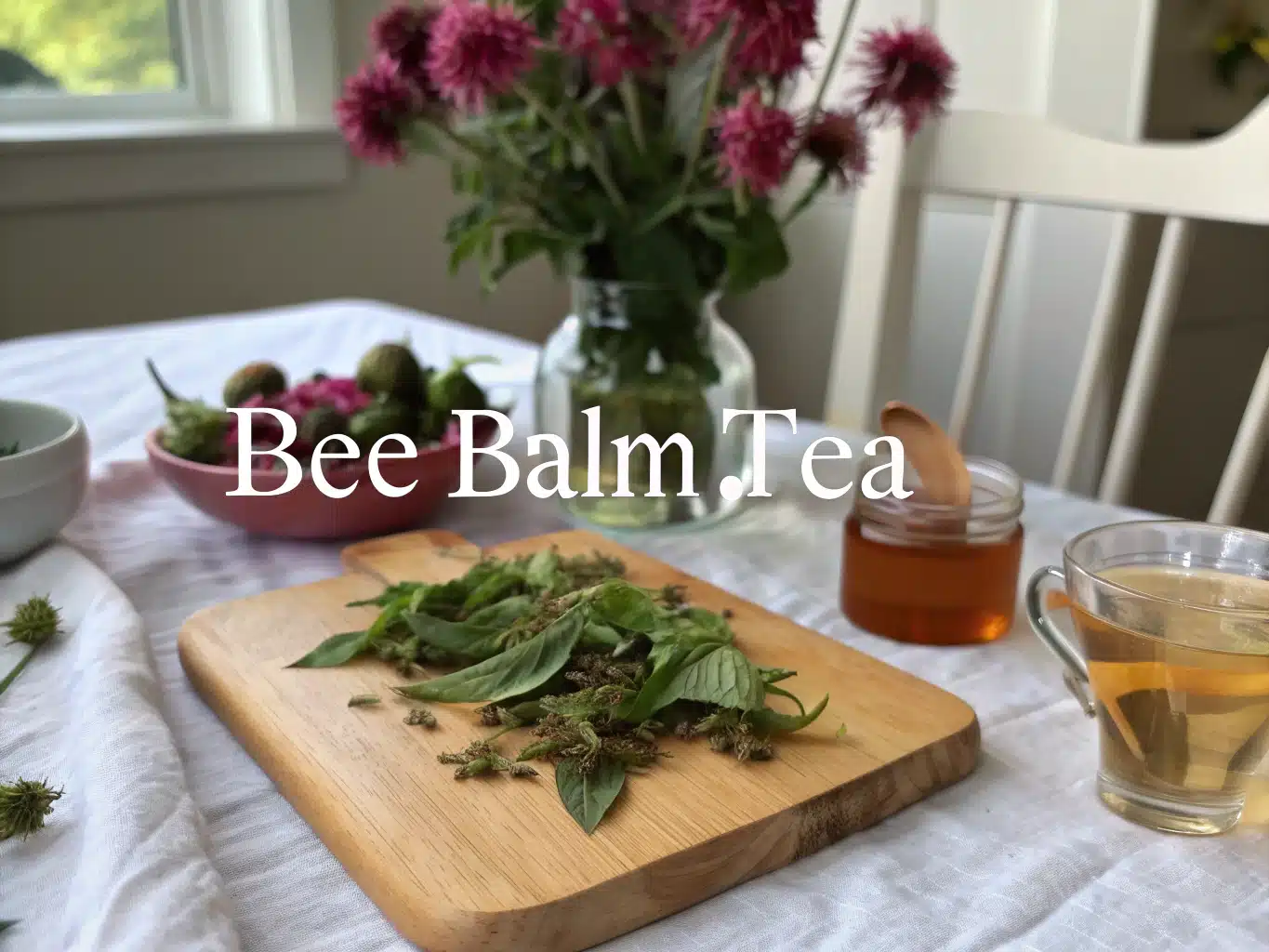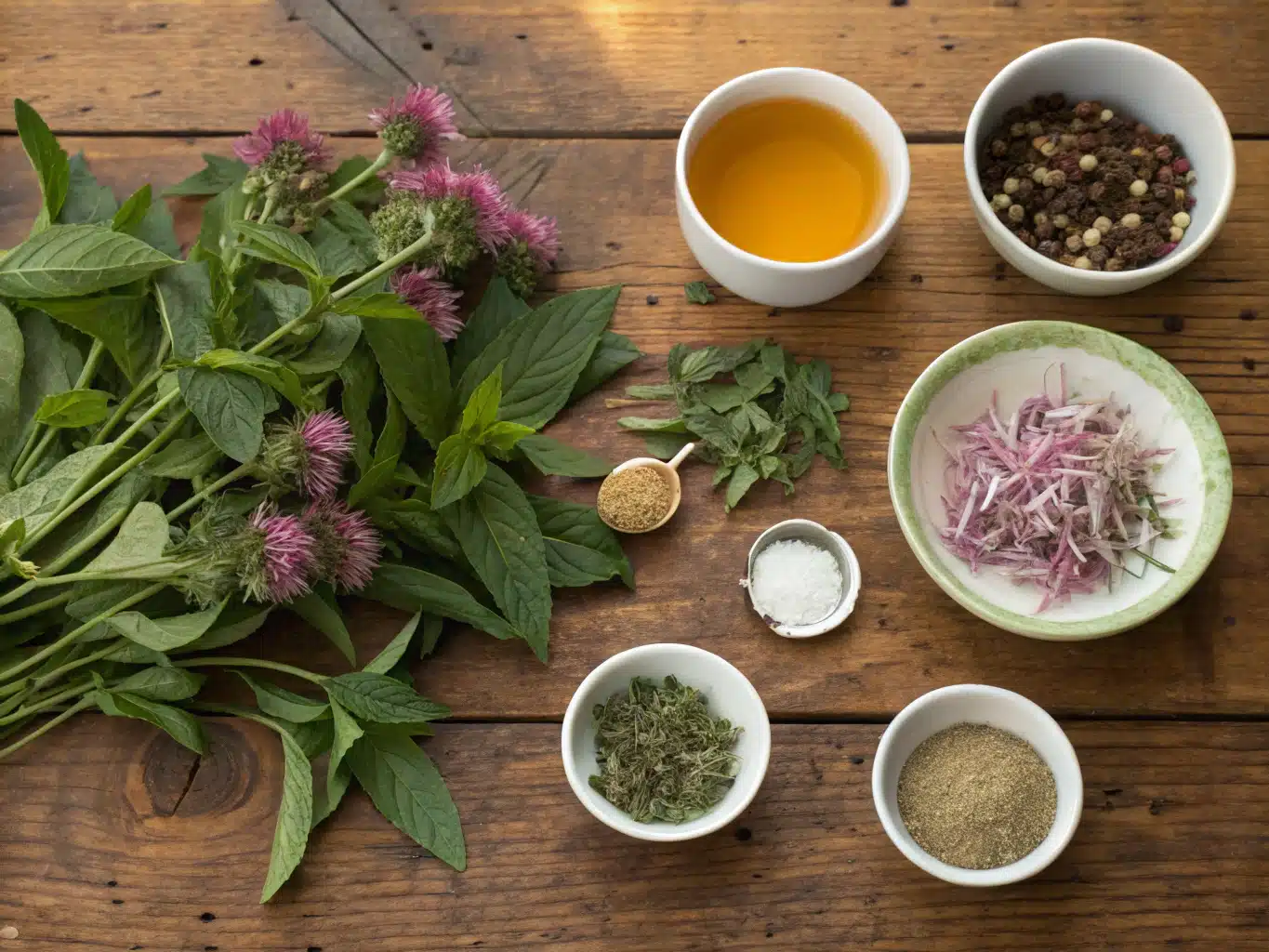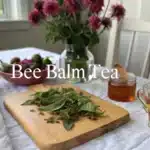
Table of Contents
Bee balm has a fragrance that brings me back to summer days in Portland—sticky sunlight, bees humming over the blossoms, and the herbal scent steeping through our open kitchen window. This bee balm tea recipe is more than just a soothing drink—it’s a ritual born from memories and inspired by flavor.
Years ago, I discovered wild bee balm (also known as Monarda) growing near my community garden plot. I was experimenting with herbal infusions for their flavor and low-caffeine benefits when a neighbor handed me a handful of purple-tipped leaves and said, “Steep these. Trust me.” That afternoon, I brewed my first cup of bee balm tea. It was slightly minty, floral, with a citrus zing—like the cooler cousin of chamomile.
I’ve been perfecting this bee balm tea recipe ever since, using homegrown leaves whenever possible. It’s gentle on the body, bold in flavor, and a plant-powered cure for dreary days. In this guide, you’ll learn how to make bee balm tea from scratch, uncover its wellness benefits, and get the real behind-the-scenes steps for crafting your own herbal infusion with heart. Let’s steep something special.
The Magic Behind Bee Balm Tea: A Bee Balm Tea Recipe Worth Savoring
What Makes Bee Balm Tea Special?
When most people think herbal tea, they think of chamomile or peppermint. But bee balm brings something delightfully different to your cup. Native to North America, bee balm belongs to the mint family and has long been used in traditional medicine for its calming and antiseptic properties.
This bee balm tea recipe not only delivers a vibrant and aromatic brew; it also taps into centuries of herbal wisdom. It’s naturally caffeine-free, which makes it perfect for winding down your day or creating a mindful moment in your mid-morning hustle. Because of the herb’s thymol content—also found in thyme—bee balm tea offers both flavor and gentle support for your respiratory system.
My version of this tea starts with either fresh bee balm leaves from my garden or dried petals stored from the summer harvest. Whether you serve it over ice or sip it warm, you’re indulging in something that bridges the ancient with the modern kitchen.
A Plant-Powered Tradition With a Twist
One of the reasons I started sharing my plant-based recipes on Plant Powered Recipe was to highlight lesser-known ingredients like bee balm. Trust me, everyone knows about rosemary and basil, but few have tapped into the versatility of bee balm.
It’s not just for tea either—check out how I used it in this skin-friendly bee balm salve recipe for a non-edible, aromatic way to use leftover petals. From healing brews to antioxidant-rich infusions, bee balm’s culinary cousin status makes it the plant-based MVP of my garden.
Now, let’s dive into the ingredients that bring this bee balm tea recipe to life.
How to Make Bee Balm Tea at Home
Ingredients List for Your Bee Balm Tea Recipe

To make one perfect mug of bee balm tea, here’s what I recommend keeping on hand. You can scale up for a teapot or a bigger batch later.
| Ingredient | Notes/Substitutions |
|---|---|
| 1 tablespoon dried bee balm leaves | Or 2 tablespoons fresh petals/leaves |
| 1 cup boiling water (8 oz) | Filtered water preferred for clean taste |
| 1 teaspoon honey | Optional; substitute with date syrup or maple |
| Fresh lemon slice | Brightens up the floral notes |
If you grow your own bee balm, harvest just before it flowers for maximum oil content. Foraged? Make sure it’s pesticide-free and identified correctly.
Timing: Brewing the Perfect Cup
Here’s how the prep breaks down:
| Step | Estimated Time |
|---|---|
| Prep time (gather & measure ingredients) | 5 minutes |
| Steeping time | 8–10 minutes |
| Total time | 15 minutes |
That’s about 25% quicker than most herbal tea preparations, thanks to bee balm releasing its oils quickly when steeped.
Step-by-Step Instructions: Crafting the Perfect Bee Balm Tea Recipe at Home
- Boil 8 oz of filtered water.
- Place dried or fresh bee balm in a tea infuser or loose in your teacup.
- Pour hot water over the herbs.
- Let steep for 8–10 minutes. Cover your mug to trap the essential oils and aroma.
- Remove herbs or strain if loose.
- Stir in honey or natural sweetener if desired.
- Add a lemon slice or twist, and sip slowly.
Tip: For iced bee balm tea, use the same recipe but double steep the herbs and refrigerate until chilled. Serve over ice with mint sprigs.
Now that you know how to brew this vibrant, floral tea, let’s explore its wellness benefits in more depth.
Bee Balm Tea and Wellness Benefits
Benefits of Drinking Bee Balm Tea
Bee balm tea isn’t just delicious—it’s a nourishing, intentional practice in your plant-based routine. Rich in antioxidants, bee balm leaves contain compounds like thymol and carvacrol, both known for antimicrobial and anti-inflammatory effects.
According to NCBI, bee balm has been used traditionally to support respiratory issues, calm indigestion, and reduce anxiety symptoms. Its calming properties make it an excellent evening ritual when you’re reducing caffeine.
Bee balm tea supports:
- Relaxation and mood balance
- Immune system boosts during seasonal changes
- Mild relief for bloating or upset stomach
- Soothing sore throats
While modern science continues researching its full effects, many herbalists consider bee balm tea a gentle alternative for daily wellness support.
Comparing Bee Balm with Other Herbal Brews
Unlike chamomile or lemon balm, bee balm has a more layered taste profile. It starts minty, swerves floral, and ends with light citrus. That complexity also gives it more versatility for blending with other botanicals like hibiscus or lavender.
Compared to green tea, which contains caffeine and tannins, bee balm is caffeine-free and gentler on the stomach. It’s an ideal replacement if you’re transitioning away from stimulants.
And while peppermint tea cools you down, bee balm offers warmth and complexity—which makes it perfect for cooler months or after rich meals.
Craving some other floral-focused flavor? My in-depth guide on bee balm’s botanical uses breaks it down in delicious detail.
Make Bee Balm Tea a Daily Ritual
Beyond the Mug: Creative Uses for Bee Balm
Once you fall in love with bee balm tea, you’ll want to expand your exploration. Aside from tea, I use bee balm in infused vinegars, herbal honey, and even DIY wellness tonics. It blends well with elderberries and rosehips for a more medicinal mixture.
If you’re crafting your own herbal pantry, drying bee balm petals in summer and storing them in airtight jars gives you ingredients for months of cold remedies and late-night beverages.
Also, let your creativity bloom—frozen bee balm tea cubes in sparkling water? Yes, please.
Growing Your Own Bee Balm at Home
For this bee balm tea recipe to truly shine, fresh ingredients are key. Luckily, bee balm (especially Monarda fistulosa) grows beautifully in most U.S. zones. It thrives in full sun and moderately moist soil, spreads easily, and bees love it—so you’re also supporting your backyard ecosystem.
Not sure how to grow and identify it? Refer to USDA Plant Guide. Bonus: harvesting your own always tastes better, and you’ll never run out during tea season.
FAQ
What are the benefits of bee balm tea?
Bee balm tea offers calming effects, supports digestion, and has antimicrobial properties thanks to compounds like thymol. It’s caffeine-free and ideal for daily stress support.
How do I brew tea from bee balm?
Steep 1 tablespoon of dried leaves or 2 tablespoons of fresh bee balm in boiling water for 8–10 minutes, then strain. You can drink it hot or serve it chilled.
Does bee balm tea contain caffeine?
No, bee balm tea is completely caffeine-free, making it ideal for evenings or for anyone sensitive to stimulants.
What does bee balm tea taste like?
Its flavor is a unique mix of mint, citrus, and floral notes. Some describe it as slightly spicy or herby with a cooling finish.
Conclusion
This bee balm tea recipe has become a small yet grounding part of my daily rhythm—a garden-born brew that bridges wellness, flavor, and remembrance. Whether you’re crafting a cozy evening ritual or just craving a tea that’s vibrant and caffeine-free, bee balm offers an herbal path worth sipping slowly.
By growing or sourcing high-quality bee balm, you’re investing in your health with every cup. It’s simple, sensory, and deeply satisfying. So the next time you’re choosing between turmeric lattes or green tea, consider reaching for bee balm. Your body (and your taste buds) will thank you.
Print
Bee Balm Tea Recipe: A Soothing Sip from My Garden to Your Cup
- Total Time: 15 minutes
- Yield: 1 cup 1x
- Diet: Vegan
Description
A vibrant, floral, caffeine-free herbal infusion with calming and digestive benefits. This bee balm tea recipe brings a minty-citrus twist to your cup, perfect for a cozy ritual or wellness boost.
Ingredients
1 tablespoon dried bee balm leaves (or 2 tablespoons fresh petals/leaves)
1 cup boiling water (8 oz), preferably filtered
1 teaspoon honey (optional; substitute with date syrup or maple)
Fresh lemon slice (optional)
Instructions
1. Boil 8 oz of filtered water.
2. Place dried or fresh bee balm in a tea infuser or loose in your teacup.
3. Pour hot water over the herbs.
4. Let steep for 8–10 minutes. Cover your mug to trap the essential oils and aroma.
5. Remove herbs or strain if loose.
6. Stir in honey or natural sweetener if desired.
7. Add a lemon slice or twist, and sip slowly.
Notes
For iced bee balm tea, double steep the herbs and refrigerate until chilled. Serve over ice with mint sprigs.
Harvest bee balm just before it flowers for maximum oil content.
Bee balm blends well with botanicals like hibiscus or lavender.
- Prep Time: 5 minutes
- Cook Time: 10 minutes
- Category: Tea
- Method: Steeping
- Cuisine: Herbal
Nutrition
- Serving Size: 1 cup
- Calories: 10
- Sugar: 1g
- Sodium: 0mg
- Fat: 0g
- Saturated Fat: 0g
- Unsaturated Fat: 0g
- Trans Fat: 0g
- Carbohydrates: 2g
- Fiber: 0g
- Protein: 0g
- Cholesterol: 0mg
Keywords: bee balm, herbal tea, caffeine-free, monarda, minty tea
